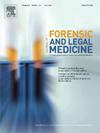Perthe's syndrome in building collapse fatalities: A forensic examination
IF 1.2
4区 医学
Q3 MEDICINE, LEGAL
引用次数: 0
Abstract
Introduction
Perthe's syndrome, or traumatic asphyxia, is a rare form of mechanical asphyxia caused by sudden, intense chest compression, leading to cervicofacial congestion, petechiae, and subconjunctival haemorrhages. Despite its forensic significance, limited literature exists on cases resulting from building collapses.
Objective
This study examines forensic autopsy findings in victims of a building collapse, highlighting characteristic diagnostic features, pathophysiology, and the role of forensic experts, local authorities, and disaster management teams.
Methods
A forensic investigation was conducted on multiple victims who sustained fatal thoracic compression due to a collapsed building following heavy rainfall. Detailed external and internal autopsy findings were recorded, including congestion patterns, petechiae distribution, and associated injuries. The role of first responders and forensic pathologists in determining the cause of death and guiding disaster response was also evaluated.
Observations
The autopsies revealed hallmark features of traumatic asphyxia, including cervicofacial congestion, petechiae, subconjunctival haemorrhages, and lung edema. Additional injuries such as rib fractures and intracranial haemorrhages were noted in select cases. The investigation emphasized the need for rapid rescue operations and improved building safety regulations.
Conclusion
This study reinforces the importance of forensic pathology in diagnosing traumatic asphyxia and underscores the necessity of coordinated emergency response strategies in structural collapse disasters.
建筑倒塌死亡中的佩尔斯综合症:法医检查
perthe’s综合征,又称外伤性窒息,是一种罕见的机械性窒息,由突然剧烈的胸部压迫引起,导致颈面充血、瘀点和结膜下出血。尽管它具有法医意义,但关于建筑物倒塌导致的案件的文献有限。目的:本研究考察了建筑倒塌受害者的法医尸检结果,强调了典型的诊断特征、病理生理学,以及法医专家、地方当局和灾害管理团队的作用。方法对暴雨后建筑物倒塌致胸部压迫致死的多例受害人进行法医鉴定。记录详细的外部和内部尸检结果,包括充血模式、瘀点分布和相关损伤。还评估了急救人员和法医病理学家在确定死因和指导救灾方面的作用。尸检显示外伤性窒息的标志性特征,包括颈面充血、瘀点、结膜下出血和肺水肿。其他损伤,如肋骨骨折和颅内出血被注意到在某些情况下。调查强调了快速救援行动和改进建筑安全法规的必要性。结论本研究强调了法医病理学在外伤性窒息诊断中的重要性,强调了在结构倒塌灾害中协调应急策略的必要性。
本文章由计算机程序翻译,如有差异,请以英文原文为准。
求助全文
约1分钟内获得全文
求助全文
来源期刊

Journal of forensic and legal medicine
MEDICINE, LEGAL-
CiteScore
2.70
自引率
6.70%
发文量
106
审稿时长
57 days
期刊介绍:
The Journal of Forensic and Legal Medicine publishes topical articles on aspects of forensic and legal medicine. Specifically the Journal supports research that explores the medical principles of care and forensic assessment of individuals, whether adult or child, in contact with the judicial system. It is a fully peer-review hybrid journal with a broad international perspective.
The Journal accepts submissions of original research, review articles, and pertinent case studies, editorials, and commentaries in relevant areas of Forensic and Legal Medicine, Context of Practice, and Education and Training.
The Journal adheres to strict publication ethical guidelines, and actively supports a culture of inclusive and representative publication.
 求助内容:
求助内容: 应助结果提醒方式:
应助结果提醒方式:


